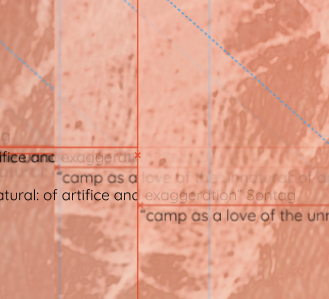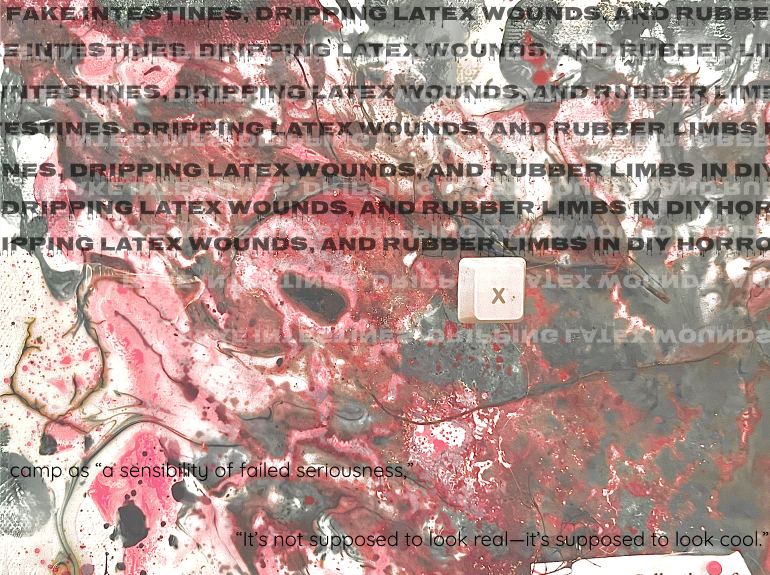Horror’s linkage to experimentation is bonded through the bending of expectations and possibilities, fear of the unknown underpinning both of these ideas .
Community collaboration and vision execution lends well to playing with aesthetics and genre bleeding, such is the case with Opal 99, a local film production working in the ecosystem of vision creation and execution.
Texture of Production
The limitations of budget, time, and tools become the site of innovation and play.
The choice to film on a miniDV tape was a loop between the aesthetic and thematic as well as accessibility and resource availability.
“A low-quality camera helps blood effects look good” says Grayce Anne Mosier, founder of Opal99, referencing traditions of practical effects and the disguises of imperfect DIY makeup and props.
Horror alchemy, behind the grain, the pixels blur and the vision of chaos runs through, “it leaves more to the imagination when you cant see every pixel in HD” says Carter Bentley Hall.
“If you shoot in 4K, you see every mistake in the prosthetics. But with DV tape, it’s fuzzy enough to sell it.” The rough edges of practical effects become part of the aesthetic, enhancing the gore while contributing to the campy charm.
Furthermore, memories of found footage ruminate in the medium, the idea of lost and found, the illusion of secrecy in a world where this could happen, “It makes you feel like you’re watching something you’re not supposed to be, that’s how I feel about Video Violence“.
“A broken road mic, a $15 mic from the thrift store and a donated mic… and sometimes those items dont even work, so we have to go in ‘post’ to recreate every single sound,” Mosier describes scrappy set ups and making do.
From the fake blood to the party scenes, the filmmaking process is deeply improvised, not just in execution but in spirit. “We told everyone to come over and that we’d have a keg and to write your name down on the sheet and you’d get credit… everyone awkwardly scuttled about and hung out with no music.” No extras, no closed sets—just a real, keg-fueled party filmed and turned into something else.
But in that fusion of real-life messiness and constructed narrative, camp is born. The filmmakers embraced happy accidents—like an actor awkwardly pausing too long on set—as moments of magic. “We could have fixed it, but we chose not to… It was funnier to have him stand there in silence then turn around and leave… and we scored it to that beat, like comedic timing.”
The soundtrack worked in tandem with these visuals to create rhythm, suspense, and a heavy sense of irony. “We built the score to match the awkward moments”
In both sound and gore, the team treated horror like a kind of punk theater: make it loud, make it messy, and make it matter.
Much of what gives these DIY projects their heart is the tension between rehearsed performance and accidental authenticity. Many of the filmmakers come from a theater background, and they see horror filmmaking as a kind of trust fall. “Film is the same kind of bravery for an actor [as theater], except it’s just a little more forgiving of what the end performance will be.” Yet there’s still a crowd watching, still stakes, and still the moment where someone has to scream, grunt, or flail—badly—until it works.

Tactile Horror
Oozing charm and cleverness, the creativity in the creation of their diy projects inevitably references sustainable, grassroots practices and a ‘can do’ spirit.
DIY horror cinema thrives at the intersection of the grotesque and the theatrical, where prosthetics become emblems of excess. These hand-crafted effects are not hidden—they’re celebrated, smeared across the screen with glee.
As Susan Sontag writes in Notes on “Camp”, “Camp is a mode of aestheticism…one way of seeing the world as an aesthetic phenomenon.” The fake intestines, dripping latex wounds, and rubber limbs in DIY horror aren’t trying to be invisible—they’re highlighted, pushed to the edge of believability in a way that produces both revulsion and joy.
This aligns with Linda Williams’ theory of “body genres,” where horror, pornography, and melodrama all push the body into extreme states of sensation and response. In DIY horror, prosthetics are physical sites of those extremes—not just mimicking violence but theatricalizing it.
The limitations of budget—cheap prosthetics, ketchup blood, stiff latex—become creative advantages. These “failures” to imitate reality are precisely what give DIY horror its camp energy.
A pool noodle, gelatin, and glycerin walk into the studio and come out a leg on film.
The prosthetic effect—created from a Styrofoam wig stand, a wig, and pasta packed into a log—embodied a grotesque creativity: “We packed all of like the meat over the log… and then we just shoved it through a couple times and hoped no children would pass by.”
This resourceful absurdity exemplifies Sontag’s definition of camp as “a sensibility of failed seriousness,” where theatricality and exaggeration are elevated to aesthetic virtues. As Grayce Anne Mosier puts it, “It’s not supposed to look real—it’s supposed to look cool.”
Bakhtin’s theory of the carnivalesque is deeply relevant here. The grotesque body—open, leaking, unfinished—is central to this horror practice. DIY prosthetics exaggerate bodily rupture in a way that’s comic, communal, and revolting all at once. As Bakhtin writes, the grotesque is about “a body in the act of becoming.” These bodies don’t die cleanly—they split open, bubble over, and resist closure.
The community around these effects—the DIY horror crew huddled around a blood rig—is just as important. Prosthetics aren’t just props; they’re a shared performance, a tactile craft that brings together horror fans, artists, and experimenters in a collaborative, campy ritual.
Horror isn’t just about jump scares and eliciting a response, its about trust, freedom and a commitment of scaring yourself in the dark, making something out of nothing.

